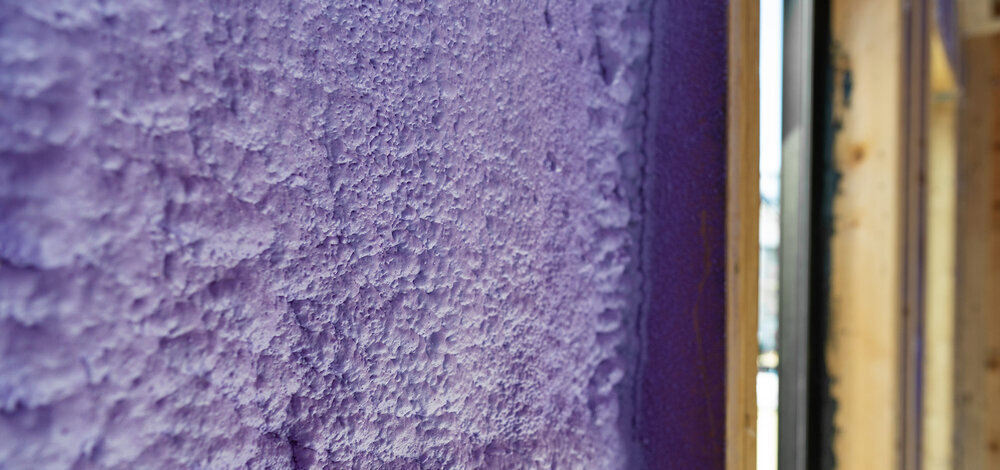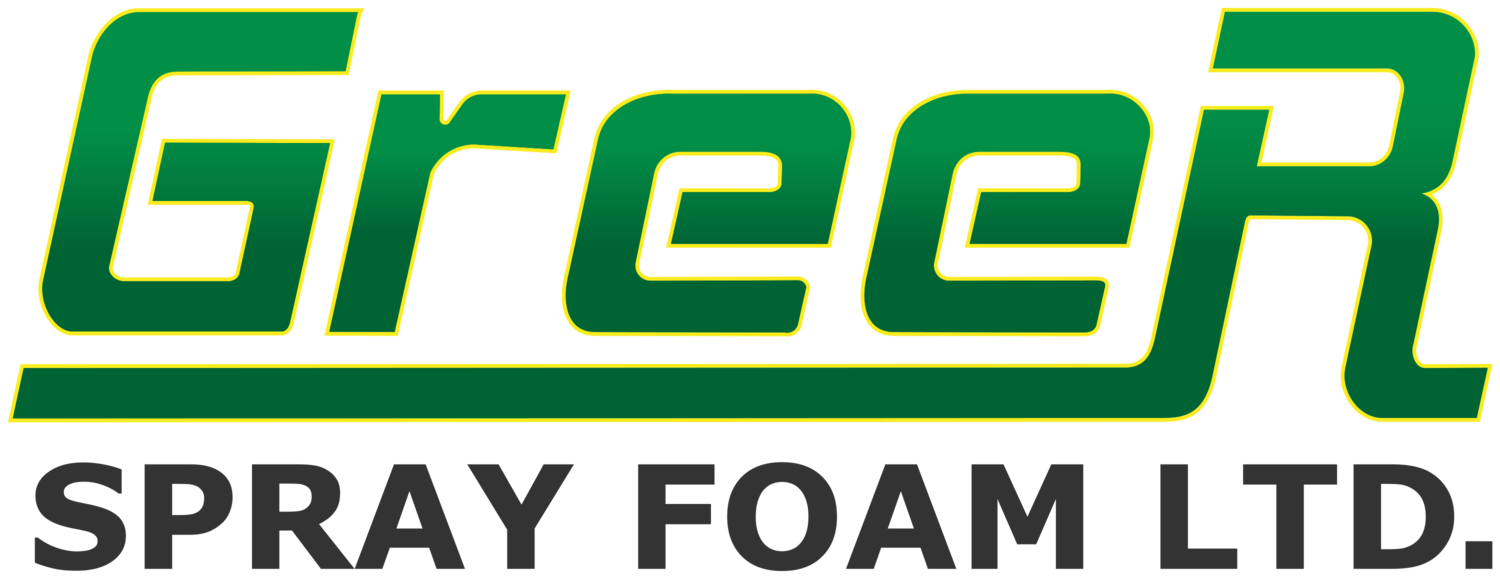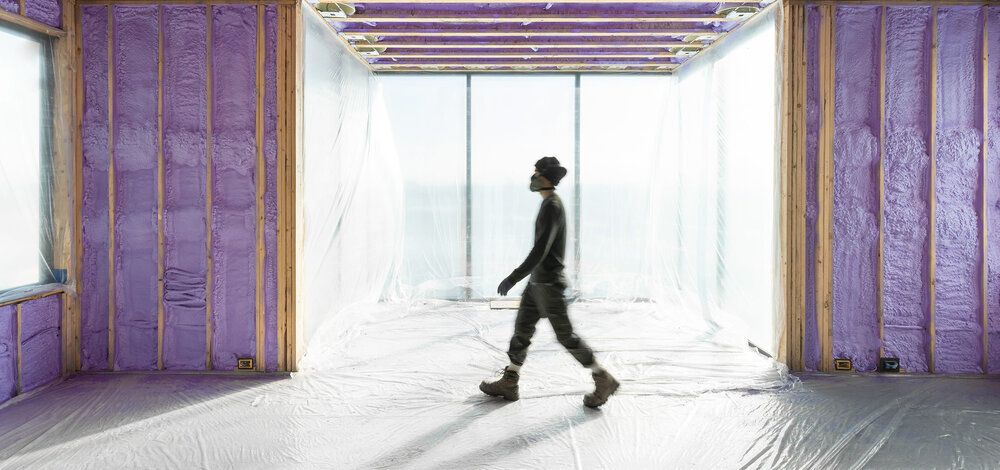
BLOG
Greer Spray Foam
Get Our Latest Advice for Your Home
Choosing an Eco-Friendly Spray Foam Insulation
In this article, we’re going to explore what makes certain insulation products more eco-friendly than others and how to choose the best one for your home or new construction project.
Did you know that approximately 40% of all global warming is attributed to building and construction activities? The majority of that 40% comes from how we heat and cool our homes, but the use of highly efficient eco-friendly spray foam products can greatly reduce that.
While spray foam has conventionally been thought of as a higher-performing, but less environmentally friendly insulation option, thanks to advancements in technology and product development that is no longer the case. In late 2020 several ultra-environmentally friendly, low GWP and high performing spray foam products were released within the Canadian market that exceeds many comparable insulations, including mineral wool, in both performance and eco-friendly properties.
Building codes and regulations are helping to minimize the environmental footprint as well by mandating higher energy-efficient homes and structures. You can reduce your contribution to global warming with the insulation products you choose to install in your home or project.
In this article, we’re going to explore what makes certain insulation products more eco-friendly than others and how to choose the best one for your home or new construction project.
EPDs and GWPs: What are they?
To understand the environmental impact a product can have, you need to look at its Environmental Product Declaration (EPD) to see how it affects its global warming potential (GWP).
Home insulation products should have an independently verified EPD to help you compare quantifiable environmental data on the use of the product. This data correlates to its potential for GWP. For example, Mineral Wool is a popular insulation material. As the density of the wool increases, so does its EPD.
Here’s an illustration to show how several popular grades of insulation compare to Walltite CM01 (our preferred insulation at Greer):
How environmentally friendly and efficient is Walltite CM01 insulation?
When using Walltite CM01 for your insulating spray foam (which, as you can see from the above chart, has among the lowest environmental footprint of all insulating materials), you get support for multiple building system functions, including a:
vapour barrier
air barrier system
water-resistant barrier
air barrier material
radon barrier
Walltite CM01 is one of the most sustainable building insulating solutions on the market, with the lowest GWP. It’s part of your sustainable construction solution and can help you heat and cool your home more effectively while minimizing your environmental footprint.
At Greer, we love using Walltite CM01 for our customer’s insulation projects. What we love is that the benefits of this foam go way beyond a safe, long-lasting insulation product. It’s an eco-friendly spray foam insulation with one of the lowest environmental footprints without sacrificing quality and performance.
To get started using the Walltite CM01 eco-friendly spray foam insulation, use our contact form to schedule your free estimate today!
How to Soundproof Your Basement Suite
Do you hear creaking floorboards when someone walks around upstairs? Today we’re going to talk about what you need to know to soundproof your basement suite.
Do you hear creaking floorboards when someone walks around upstairs? Do sounds travel through your walls? If so, you need to soundproof your home.
Today we’re going to talk about what you need to know to soundproof your basement suite.
3 reasons to soundproof your basement suite
There are many reasons to get your basement suite soundproofed including:
Creating a noise barrier: Give your downstairs tenants some quiet so they don’t hear you sneaking to the kitchen at midnight for a snack.
Increase your homes’ value: Knowing that a home has soundproofing can increase the resale value.
You save on heating costs: When you use spray foam insulation as your soundproofing material, you’re also creating a heat barrier to conserve heat in your suite so you spend less money heating the already chilly space.
Basements are also popular for “mancaves,” music rooms, and other quiet sanctuaries in your home. If you have basement rooms that could use a little quiet, soundproofing is easy to do with an insulating material to absorb or stop the sounds from upstairs going downstairs (and vice versa).
Where to soundproof a basement
When you’re trying to prevent noise from upstairs going down or vice versa, you want to put the sound barrier in the basement ceiling. This will involve filling the area between the joists with your sound-insulating material.
When soundproofing the basement from impact noise (like walking or things falling on the floor above) it helps to install carpet with a thick underlay upstairs. If you have hard floors upstairs, install an acoustic mat or cushioning under the floor to absorb the sound before it transfers to the structure of your floor and then the basement
You can also use soundproofing to minimize sounds from outside (like a busy street or noisy neighbours) from coming into the suite. This is when you’ll want soundproofing barriers in the exterior walls of your home.
What you need to know before installation
First of all, you need to ensure that your basement suite is unoccupied. The process to spray sound-insulating foam into your walls and ceilings requires us to remove portions of the ceiling and drywall. As you can imagine this can get very dusty and messy. Be sure the basement suite is not occupied during the project and that any sensitive furniture, plants, and other items are removed for at least a couple of days.
To spray insulating foam in the ceiling and wall, your soundproofing team will be removing chunks of drywall that will need repair when they’re done. If your contractor doesn’t have someone on their team to do this, ensure you book a separate contractor to complete this as soon as possible.
There are methods available that are employed by some contractors to drill holes in the drywall ceiling and inject insulation into the cavity space, but these methods are not recommended. We find that with a blind application such as this one, there tend to be voids in the insulation throughout the ceiling. As such, you are often left with a sizeable bill coupled with an inferior result!
Do you have a finished basement area or downstairs suite that you want to soundproof? Greer Spray Foam is a trusted basement insulation contractor in Vancouver, BC. Contact the team at Greer Spray foam for a free estimate today.
How to Properly Insulate Your Attic
How much money are you wasting every year because your home is not properly insulated? Keep the heat you’re already paying for inside your home by ensuring your attic is well-insulated to prevent heat from escaping.
How much money are you wasting every year because your home is not properly insulated? Keep the heat you’re already paying for inside your home by ensuring your attic is well-insulated to prevent heat from escaping.
Here’s what you need to know about properly insulating your attic:
The science of heat
When the air in your home is heated, it expands, becomes less dense than the cooler air around it, and rises. So, it’s no surprise that heat can often escape through your roof. A properly insulated attic or roof of your home will keep as much of that heat inside as possible and you waste less energy (and money) heating your home.
Now, we’re not talking about a 100% airtight seal around your entire home. Your home still needs to breathe. But when you get a professional to install the insulation in your attic, you get the right amount of insulation to provide the best seal that still allows your home to expel excess moisture where needed.
Why insulate your attic?
Insulating your home has several benefits including:
Reducing your energy costs: When less heat escapes through your attic, your heating bill goes down and you’ll save money (often as much as $1000 over a few years)
Increasing your homes’ value: A more energy-efficient home makes it attractive to buyers and can increase your homes’ value and sale price.
Ensuring building codes are up-to-spec: When you have your insulation installed by a professional (like us), you can rest assured that it is done to code.
Moisture/vapour and air barriers
You want your attic to have both air and moisture or vapour barriers. Air barriers prevent heat from escaping and cold from entering the home. Installing a vapour or moisture barrier will help prevent moisture from diffusing through walls, floors, and ceilings. If your home was constructed without a moisture/vapour barrier, there are options that can be put in place to supplement that as well! (ie: use spray foam, install a vapour block paint to your drywall, etc.).
Types of attic insulation
Batt insulation
Batt insulation is made of fibreglass that you hand-place in your attic or inside your walls. Batt Insulation is not your best option for an existing attic, as it is extremely difficult to maneuver a large quantity of insulation bags up through a tight attic hatch. They are also difficult to properly fit in place as attics usually have a shortage of space that can be further complicated by existing ducts, fans, etc. that make it difficult to install Batt Insulation continuously.
Loosefill insulation
This is a popular insulation found in new homes, especially in attic spaces! You’ll need a specially designed blower machine and safety equipment to blow the loose fibreglass chunks around your attic. Loosefill is similar to Batt Insulation when it comes to performance, but it is far easier to install as it is blown in place through a hose similar to a vacuum hose by a qualified applicator. Loosefill can also be blown over ducts, wood framing, around fans, etc. to provide a more continuous thermal layer. It can also be installed over existing Batt Insulation, Loosefill Insulation, or Spray Foam Insulation to essentially upgrade your existing thermal performance.
Spray foam
Spray foam is your best option to maximize heat efficiency in your home. It quickly and efficiently fills nooks and crannies so you’re getting far superior coverage and it serves as both a moisture and air barrier. And because of its hard finish, it doesn’t tend to attract rodents or insects that sometimes have a tendency to gravitate to these sorts of spaces. The downside of spray foam insulation is it isn’t viable to install in all attic spaces. If you already have Batt Insulation or Loosefill insulation installed in your attic, this would typically need to be removed prior to installing Spray Foam as the product would need to bond directly to a substrate. Removing insulation can be costly, as can Spray Foam in general, but if those factors can be overcome it is by far the most efficient and durable insulating product available.
Greer Spray Foam is a trusted attic insulation contractor in Vancouver, BC. We specialize in residential and commercial insulation projects including batt insulation, loosefill, and spray foam insulation.
What’s the best way to properly insulate your attic
The bare minimum recommended is batt insulation, but we usually recommend starting with a layer of spray foam as a base to ensure no heat escapes through the hooks and crannies that are hard to see.
If you’re looking for an insurable, bondable installer for insulation in your attic, give the team at Greer Spray Foam a call today for your free estimate.
3 Big, Important Reasons Why You Should Spray Foam Your Crawl Space (And How To Do It)
It’s not an area of your home you spend time in every day, but it’s still one of the most important rooms in your home. It’s your crawl space! If not properly insulated, it can cause a lot of problems in your home and also affect your home’s resale value!
It’s not an area of your home you spend time in every day, but it’s still one of the most important rooms in your home. It’s your crawl space! If not properly insulated, it can cause a lot of problems in your home and also affect your home’s resale value!
Here’s what you need to know about how to spray foam a crawl space:
This diagram demonstrates how to spray foam a crawl space. Crawl space insulation is helpful in minimizing floorboard creaks, creating a temperature barrier and minimizing musty odors.
Spray foam will minimize floor-board creaks
Have you ever tried to sneak to the kitchen for a snack at night and the floorboard squeak under you? When you apply a high-density spray foam product to the ceiling of your crawlspace this can help to minimize (and in most cases completely eliminate) the squeaking so you can get that piece of chocolate cake at 1 am without being discovered!
Spray foam will create a temperature/air barrier
Your crawl space is the coldest, most humid area of your home. Spray foam applied to the ceiling of your crawl space acts as a thermal, air, and gas barrier between this area and your main living area above. The foam we use at Greer Spray Foam is a high-quality, environmentally friendly closed-cell spray foam product that provides insulation and an impermeable barrier for moisture and air without the need for a separate vapour barrier.
Separating your crawl space and main living areas with insulating spray foam will help keep your heating bill down as cold crawl space air won’t seep into the warmer areas of your home. This will mean you can put your slippers away, even in the winter months!
Spray foam will create a smell barrier
The air in crawl spaces is often moist and dank-smelling. You don’t want the main living areas of your home to smell like this too! Using spray foam insulating material to create a barrier on the ceiling of your crawl space will prevent stinky crawl space air from penetrating through the floorboards into your home. Our purple spray foam is extremely effective at reducing air movement (and the smells it carries) through openings, cracks, and crevices.
Can I spray foam my crawlspace myself?
In the age of being able to Google nearly any home DIY project you need, this is one of those projects that if you want it done right and safely, it’s best left to the professionals (ideally, professionals with proper safety and application equipment, so can ensure every detail is done quickly and efficiently.) Without proper safety equipment and technique, the foam can be hazardous.
(Don’t worry though! Once the foam has cured it’s no longer a hazard for you and your family)
How to spray foam a crawlspace
When people ask us how to spray foam a crawl space, they ask whether they should spray foam the walls or just the ceiling. While it’s not uncommon to spray the walls, it comes with an additional set of considerations. Cold and smells can still seep through your crawlspace floor (yes even if the floor is concrete).
Insulating your crawl space walls may also require proper ventilation systems installed in your space to prevent mold growth if humidity gets trapped there. Your better bet, and what we recommend for most clients, is to spray from the ceilings of your crawlspace. Let your crawlspace stay cooler, while the main living area of your home is insulated from the crawlspace.
Insulating the ceilings of your crawlspace can save you up to 30% on your heating bill. Ask us about our crawl space insulation services to have your home professionally insulated with spray foam. Our foam is clean, environmentally friendly, and can provide you significant energy savings on your next heating bill! We’ll crawl through your crawl space so you don’t have to!
Interested in getting your crawl space insulated? Use our contact form to tell us about your crawl space insulating needs or concerns. We’ll send an estimator (with protective PPE to keep you and our team safe) to your home to perform a quick on-site inspection and provide you with a quote.







